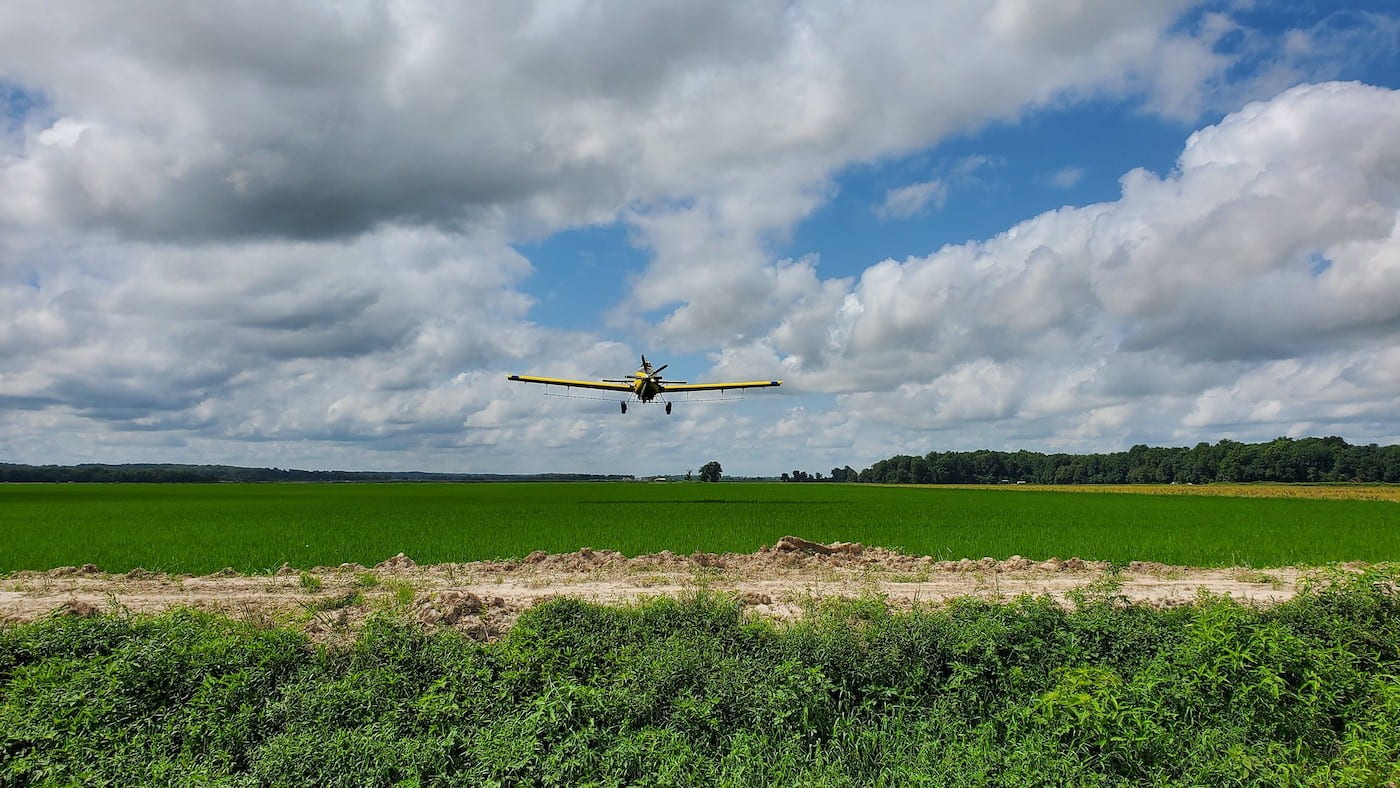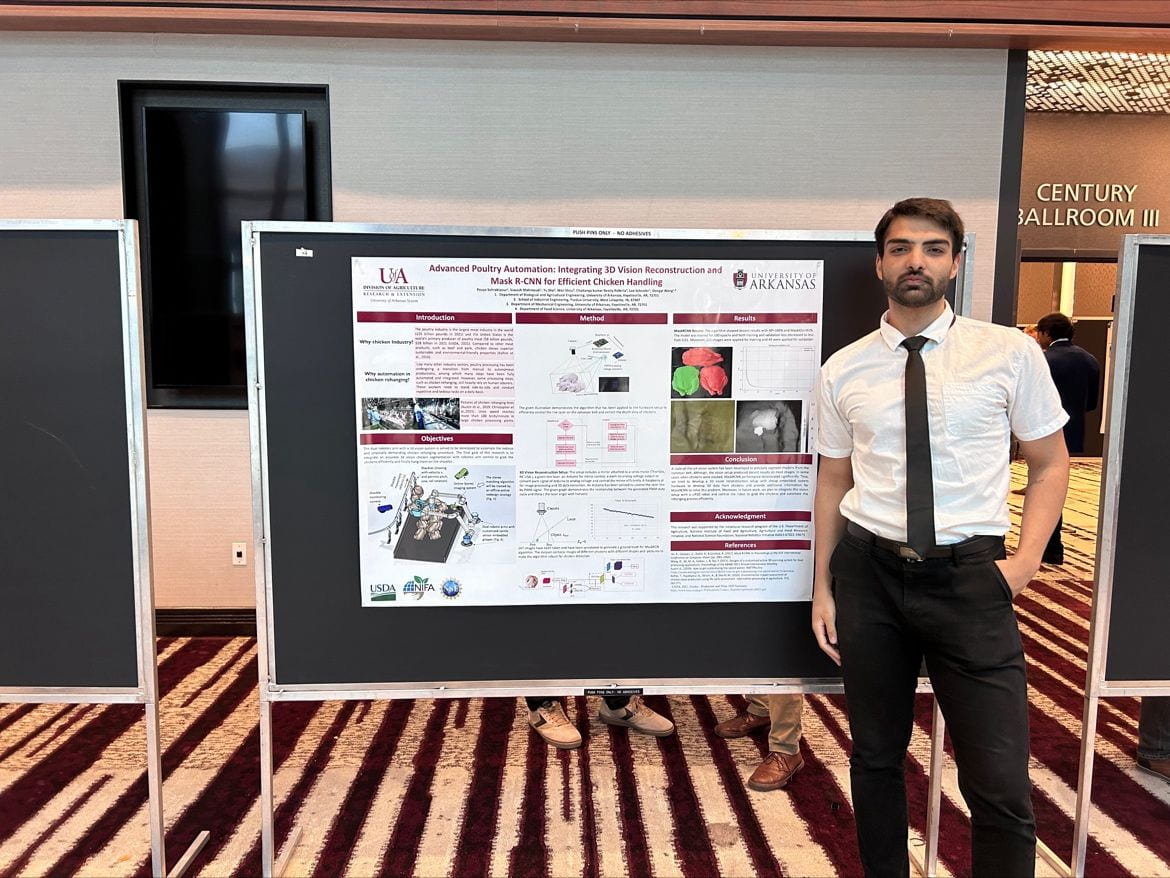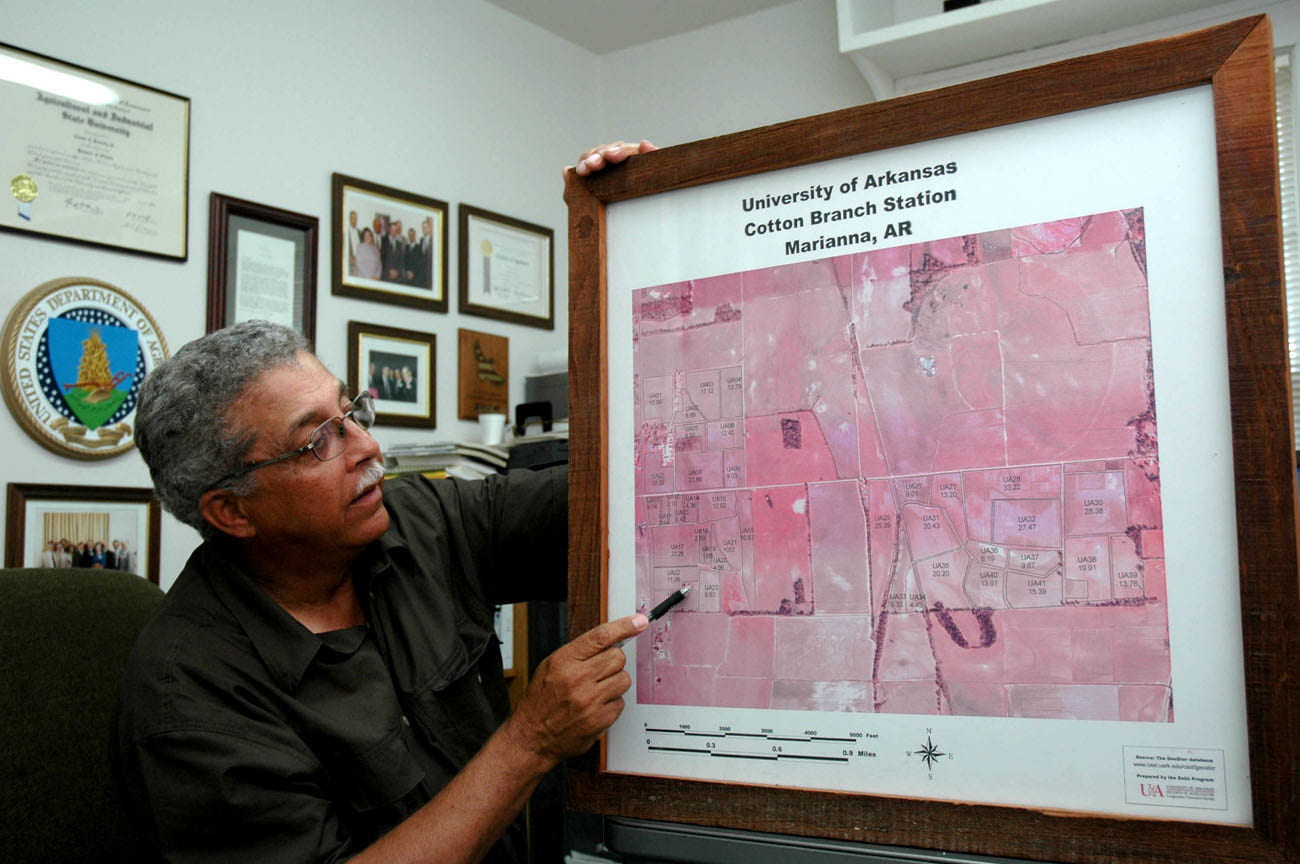Herbicide Drift Study Validates EPA Prediction Models, Provides New Recommendations
Understanding drift potential of herbicide application methods could reduce drift
By John Lovett – Apr. 6, 2023

DRIFT STUDY — A University of Arkansas System Division of Agriculture study validated U.S. Environmental Protection Agency herbicide drift prediction models. (U of A System Division of Ag photo)
FAYETTEVILLE, Ark. — Farmers and agricultural aviators may be able to reduce herbicide drift by making simple adjustments, according to a recently published study.
The study, published in Nature’s “Scientific Reports” journal late last year, was conducted to better understand the drift potential from herbicide applications made on the ground and through the air.
“Drift” is when the wind carries an herbicide application off-target and causes unintended damage to a nearby crop. An average of 400 drift complaints have been filed with the Arkansas State Plant Board each year since 2018 in Arkansas, according to Tommy Butts, assistant professor and extension weed scientist with the University of Arkansas System Division of Agriculture.
“If we can reduce drift complaints by 50 percent in Arkansas annually because of a better understanding of application drift potential, and use mitigation strategies recommended from this research, nearly $2 million could be saved annually for Arkansas growers and applicators,” Butts said.
Researchers with the Arkansas Agricultural Experiment Station, the research arm of the University of Arkansas System Division of Agriculture, conducted the trials at the Rice Research and Extension Center in Stuttgart as part of a study to determine the effects of spray drift from ground and air-based applications on potential pollinator foraging sources. Although self-pollinating, soybeans offer a foraging source late in the season and are often grown near rice fields.
The study validated U.S. Environmental Protection Agency herbicide drift prediction models, AgDISPersal and AgDRIFT, and provides recommendations for aerial applications of Loyant®. This herbicide is commonly used on rice fields to control barnyardgrass, sedges and pigweed, but causes harm to soybean crops.
“Validating those models was a big piece of the puzzle,” Butts said. “Considering any pushes to ban aerial herbicide applications, we say use these EPA models. They are field validated, and they make sense. We can implement more drift mitigation strategies, we can do better, but we don’t need an outright ban on aerial applications if we can figure out ways to reduce drift and have models we can trust.”
The share of ground and aerial-based herbicide applications is nearly equal in Arkansas, at 49 and 51 percent, respectively.
Based on their field measurements, Butts said the computer simulation models from AgDISPersal did “very well” predicting drift on aerial applications. AgDRIFT’s results better fit the data gathered from ground applications, he added. AgDRIFT is a modified version of AgDISPersal that serves as an initial screening model for estimating downwind drift. The AgDISPersal model allows for more detailed input conditions and higher-level modeling of aerial and ground spray applications, Butts noted.
Results from the research indicated that aerial applications had an increase in downwind spray drift of about three- to five-fold compared to the ground application across all data collected.
“Severe reductions in soybean canopy coverage and flowers or pods were observed from downwind spray drift from both the ground and aerial application methods, indicating soybean is extremely sensitive to Loyant®, and drift mitigation methods need to be implemented for both application methods when applying this herbicide,” Butts wrote.
Researchers found that soybean reproductive structures were reduced by 25 percent up to 100 feet downwind from a ground-based application. Drift from aerial applications damaged nearly 100 percent of soybean reproductive structures at 200 feet downwind.
“When you think of a plane flying 160 mph and 15 feet off the ground, that’s really not too bad, and that was with only one upwind swath adjustment,” Butts said.
The swath is the intended area which is effectively covered by the sprayer. A swath width adjustment creates a buffer zone between a potential off-target area, Butts said. Producers can treat the buffer zone with a ground-based method to reduce drift potential or come back with an aerial application on a day when the wind direction has changed.
Butts said previous application spray drift research indicated a range in downwind spray drift deposits at farther distances. However, results among both aerial and ground spray drift studies vary depending on the droplet size, and other factors like wind speed, temperature and humidity.
Droplet size from the sprayer is a significant factor in spray drift. The finer, or smaller, the beginning droplet size, the more potential there is for herbicide drift, Butts said.
Recommendations
Based on their research, Butts and co-authors of the study recommend that aerial applicators use a “coarse” droplet size and make three to five complete upwind swath width adjustments to reduce spray drift potential.
Drift mitigation efforts for both application methods also include drift reduction adjuvants, reduced boom and flight heights, and applying when the wind direction is more favorable, blowing away from sensitive areas, the researchers noted.
For the ground-based applications, researchers used a Case 5550 AimPoint tractor with a 100-foot boom, set 3 feet above the ground, driving 20 mph across the test area. They used an AirTractor 802A with a 72-foot swath width for aerial applications. The plane flew an average of 15 feet above the ground with an average airspeed of 145 mph. Ten spray passes for both application methods occurred with an average 8 mph crosswind.
The impacts of herbicide drift were measured using water-sensitive cards, and by evaluating the effects on soybean reproductive structures. The study noted that future research should investigate repeated exposure potential and identify the influence of additional herbicides on other plants to develop a database of potential impacts on pollinators’ foraging sources.
The researchers’ work was published in Nature’s “Scientific Reports” journal in October 2022: Herbicide spray drift from ground and aerial applications: Implications for potential pollinator foraging sources.
Funding for this research was provided by the USDA-Agricultural Research Service. Additional support was provided through the Arkansas Soybean Promotion Board Checkoff funds. The authors also expressed appreciation for research assistance provided by Tri-County Farmers Associates and Cole Hartley of Hartley Flying Service.
To learn more about Division of Agriculture research, visit the Arkansas Agricultural Experiment Station website: https://aaes.uada.edu. Follow us on 𝕏 at @ArkAgResearch and Instagram at @ArkAgResearch.
To learn about Extension Programs in Arkansas, contact your local Cooperative Extension Service agent or visit https://uaex.uada.edu/. Follow us on 𝕏 at @AR_Extension.
To learn more about the Division of Agriculture, visit https://uada.edu/. Follow us on 𝕏 at @AgInArk.
About the Division of Agriculture
The University of Arkansas System Division of Agriculture’s mission is to strengthen agriculture, communities, and families by connecting trusted research to the adoption of best practices. Through the Agricultural Experiment Station and the Cooperative Extension Service, the Division of Agriculture conducts research and extension work within the nation’s historic land grant education system.
The Division of Agriculture is one of 20 entities within the University of Arkansas System. It has offices in all 75 counties in Arkansas and faculty on five system campuses.
The University of Arkansas System Division of Agriculture offers all its Extension and Research programs and services without regard to race, color, sex, gender identity, sexual orientation, national origin, religion, age, disability, marital or veteran status, genetic information, or any other legally protected status, and is an Affirmative Action/Equal Opportunity Employer.




